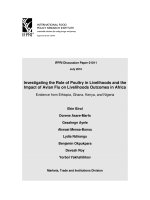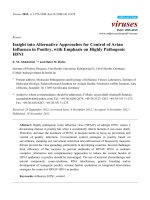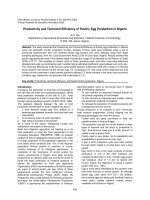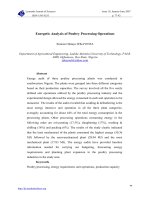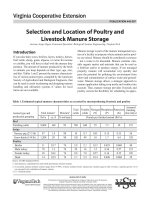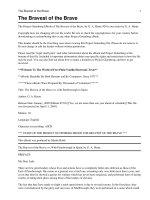Alignment of poultry sector actors with avian influenza control pot
Bạn đang xem bản rút gọn của tài liệu. Xem và tải ngay bản đầy đủ của tài liệu tại đây (404.35 KB, 21 trang )
Controlling Avian Flu and Protecting People’s
Livelihoods in the Mekong Region, Africa and Indonesia
A Collaborative Research
Project Funded by:
Implemented by:
Alignment of poultry sector actors
with avian influenza control
Bernard Bett, Iheanacho Okike, Fred Unger,
Thomas Randolph
ILRI
Acknowledgements
Supply Chain Actors
DVS - 5 countries
Partners – IFPRI/RVF
Consultants – J. Rushton and T. Wilsmore
Collaborators
Iwan Willyanto
Fassil Kelemework
Dennis Onkundi
Anthony Ikpi
Paa Kobina Turkson
• To assess the level of compliance of poultry
value chain actors in backyard and small-
scale broiler and layer chicken production
and marketing systems with HPAI control
measures
– Compliance - state of being in “agreement with”
• measures are likely to be used more effectively and widely
Objective
Key questions
• What mitigation measures are likely to enjoy
better compliance therefore achieve technical
effectiveness?
• For each control measure, where do potential
compliance fail points lie and how might they
be addressed?
Controlling Avian Flu and Protecting People’s Livelihoods | Africa, Indonesia, Mekong Region.
Presumptions
The actors’ willingness to comply depends on:
• Actors’ capacity to comply
– Capital, knowledge, information, etc
• Their current practices
– Does it require major change in current practices?
• Incentives they face
– Benefits (monetary, increased productivity)
Controlling Avian Flu and Protecting People’s Livelihoods | Africa, Indonesia, Mekong Region.
Materials and Methods
• Unit of analysis:
– A live bird supply chain rather than individual actors
• Value chains:
– Backyard, small-scale broiler and layer live-bird supply chains
(corresponding to FAO sector 3 and sector 4)
• Likert questionnaires tailored to each actor and mitigation
measure
• Mitigation measures assessed:
– Biosecurity, reporting, culling and compensation,
movement control and vaccination (indonesia)
Controlling Avian Flu and Protecting People’s Livelihoods | Africa, Indonesia, Mekong Region.
Controlling Avian Flu and Protecting People’s Livelihoods | Africa, Indonesia, Mekong Region.
Examples of Likert items on culling and compensation
Practices:
Q. Some producers may try to sell their chickens quickly before culling.
Strongly agree 1 Agree 2 Neither agree or disagree 3
Disagree 4 Strongly disagree 5 Don’t know 0
Incentives:
Q. If I don’t let my chickens get culled, they may die anyways and I won’t get compensated
Strongly agree 5 Agree 4 Neither agree or disagree 3
Disagree 2 Strongly disagree 1 Don’t know 0
Capacities:
Q. I can cooperate with culling because my poultry business is just a portion of my income
Strongly agree 5 Agree 4 Neither agree or disagree 3
Disagree 2 Strongly disagree 1 Don’t know 0
Which mitigation measures are likely to enjoy
better compliance and therefore achieve the
expected technical effectiveness?
Controlling Avian Flu and Protecting People’s Livelihoods | Africa, Indonesia, Mekong Region.
Controlling Avian Flu and Protecting People’s Livelihoods | Africa, Indonesia, Mekong Region.
Mitigation
measure
Value Chain Actors
Mitigation
agents
All Actors
and Agents
Biosecurity
3.46
3.39
3.44
Vaccination
3.30
3.38
3.33
Movement control
3.23
3.02
3.21
Reporting
3.14
3.49
3.20
Culling with compensation
2.93
3.43
3.02
Results on ANOVA test
F= 37.8;
p < 0.001
F= 5.33;
p < 0.001
F= 29.36;
p < 0.001
Mean score for each mitigation measure
Controlling Avian Flu and Protecting People’s Livelihoods | Africa, Indonesia, Mekong Region.
Ranking by value chain actors
Rank
Indonesia
Nigeria
Ghana
Kenya
Ethiopia
1
Biosecurity
Biosecurity
Movement
control
Reporting
Biosecurity
2
Vaccination
Reporting
Culling and
compensation
Biosecurity
Movement
control
3
Movement
control
Movement
control
Biosecurity
Movement
control
Reporting
4
Reporting
Culling and
compensation
Reporting
Culling and
compensation
Culling and
compensation
5
Culling and
compensation
C
P
C
P
C
C
P
P
P
C
C
P
P
C
C
C
P
C
I
P
P
• Improving biosecurity is the control measure expected to enjoy the most
compliance across the actors in chicken value chains originating in sectors 3 and
4.
• Culling and compensation appears to be the most difficult to achieve sufficient
compliance to ensure its effectiveness.
Controlling Avian Flu and Protecting People’s Livelihoods | Africa, Indonesia, Mekong Region.
Ranking by Mitigation agents
Rank
Indonesia
Nigeria
Ghana
Kenya
Ethiopia
1
Reporting
Reporting
Reporting
Reporting
Movement
control
2
Culling and
compensation
Culling and
compensation
Biosecurity
Movement
control
Reporting
3
Biosecurity
Biosecurity
Movement
control
Culling and
compensation
Biosecurity
4
Vaccination
Movement
control
Culling and
compensation
Biosecurity
Culling and
compensation
5
Movement
control
C
C
P
I
I
I
I
C
C
I
I
P
P
C
C
C
P
I
P
P
C
• Mitigation agents compliant with disease reporting.
• Mis-match between ranking given by value chain actors from those of mitigation
agents
For each control measure, where do potential
compliance fail-points appear to lie and how
might they be addressed?
Controlling Avian Flu and Protecting People’s Livelihoods | Africa, Indonesia, Mekong Region.
Actors with the least alignment score for each mitigation measure
Controlling Avian Flu and Protecting People’s Livelihoods | Africa, Indonesia, Mekong Region.
• Biosecurity – S4 producers and transporter
• Culling and compensation – Trader/retailer
Rank
Indonesia
Nigeria
Ghana
Kenya
Ethiopia
Biosecurity
S4 producer
Trader
S3 layer pr.
S4 producer
Retailer
Transporter
Transporter
S3 producer
Trader
Transporter
S4 producer
Retailer
Transporter
Retailer
Trader
Reporting
S4 producer
Trader
S3 layer pr.
S4 producer
Retailer
Trader
S4 producer
Transporter
Trader
S4 producer
S3 broiler pr.
S3 layer pr.
Retailer
Transporter
Trader/S4 pr.
Movement
control
Broiler
Trader
S3 layer pr.
Trader
Retailer
S4 producer
S4 producer
Retailer
Transporter
Trader
S4 producer
Retailer
Transporter
S3 layer pr.
Trader
Culling and
compensation
Trader
S4 layer pr.
S3 broiler pr.
Trader
Retailer
S3 layer
Retailer
S3 layer pr.
S4 producer
Trader
Retailer
S4 producer
Trader
Retailer
S4 producer
Vaccination
S4 producer
S3 layer pr.
S3 broiler pr.
Key Findings
Suggestions to improve
compliance
Potential fail-points for
compliance with biosecurity lie
mainly in the backyard chicken
value chain among both
producers and transporters,
mostly due to inherently weak
capacity
Improve access to
information and financial
resources through training,
micro-credit to build
human resource capacity
Subsidize actor investment
Key Findings
Suggestions to improve
compliance
Vaccination against HPAI is
inconsistent with current S4
producer practices
Attitudes of backyard chicken
farmers that consider preventive
vaccination against chicken
diseases in backyard flocks as low
priority or unneeded
Messages targeting this
specific behaviour in
places where vaccination
can be reliably used
Key Findings
Suggestions to improve
compliance
Timely reporting of outbreaks by
most actors, especially backyard
chicken producers, is contrary to
their current practices and
attitudes
More specific messages
highlighting benefits and
need for timely reporting
and trust-building
Devise appropriate
penalties for failure to
report
Key Findings
Suggestions to improve
compliance
Weak capacity among small-scale
commercial chicken farmers and
traders in terms of absorbing
extra holding costs when
movement controls are imposed
create potential fail-points for
successful implementation of such
controls
Adjust movement controls
strategically
Subsidize or compensate
the extra costs incurred
Key Findings
Suggestions to improve
compliance
The expected poor compliance
with culling and compensation
appears to be related to:
Poor alignment with existing
practices and attitudes among
all categories of value chain
actors
Capacity (from disaggregated
analysis)
The reasons behind the
existing practices merit
more investigation
Resilience to income
shocks can be addressed
by attention to equity and
timeliness in
administration of
compensation
Key Findings
Suggestions to improve
compliance
The expected poor compliance
with culling and compensation
appears to be related to:
Poor alignment with existing
practices and attitudes among
all categories of value chain
actors
Capacity (from disaggregated
analysis)
The reasons behind the
existing practices merit
more investigation
Resilience to income
shocks can be addressed
by attention to equity and
timeliness in
administration of
compensation
Controlling Avian Flu and Protecting People’s Livelihoods | Africa, Indonesia, Mekong Region.
Key Findings
Suggestions to improve
compliance
Mismatch between types of
mitigation measures that are
compliant with value chain actors’
verses mitigation agents’ socio-
economic characteristics
Frequent needs
assessments/consultations
by mitigation agents
Thank You
Value chain – key findings
Controlling Avian Flu and Protecting People’s Livelihoods | Africa, Indonesia, Mekong Region.
• Broiler, layer and indigenous poultry producers, traders, transporters,
retailers and consumers studied
• Uneven coordination and governance mechanisms exist in each chain
studied, with limited evidence of chain “champions” to drive and
coordinate chains
• Livelihoods and economic impacts of HPAI were often severe
throughout the chain, though alternative activities sometimes
mitigated impacts
• Government response measures have had variable success, and
focused overwhelmingly on upstream actors (e.g. producers), but not
on the chain
• Regional contexts relating to strong consumer sovereignty in “buyer-
driven” chains matter, as do their interactions
